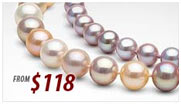Cultured Pearl Surface Quality
No two pearls are alike, and one of the factors that makes each different is its surface quality. Virtually no pearl is perfect, and any flawless specimens are treasures
The majority of pearl buyers will have a degree of surface imperfections on their gemstones. Pearl aficionados know that even the finest pearls will have irregularities on the surface. The key factors to surface quality irregularities are how noticeable they are and if they seriously affect the durability of the pearl.
Types of Surface Quality Characteristics
Serious surface quality issues are usually chips and gaps, which will lower the value of even the most lustrous pearls. Why? These particular imperfections can cause the pearl to crack or peel. Other characteristics include:
-
Abrasions - scratches or scuffs that affect the luster or color of the pearl.
-
Spots - minor color variations.
-
Bumps - tiny bubbles on the surface of the pearl
-
Wrinkles - where the nacre isn't smooth.
Some surface characteristics are hardly noticeable, even to a pearl expert. A good example would be a minor flaw near the hole drilled in the pearl.
Factors That Affect Surface Quality
Some value factors can actually make up for a few minor flaws in a pearl. If a gem is large, a couple of small imperfections won't hurt its value. High luster helps, because it can actually make some surface quality variances less noticeable. One or two pearls with noticeable imperfections in a strand may not lower its value if the rest of the pearls are near flawless, because value is determined by uniformity, not minor variations.
![]()
![]()










































